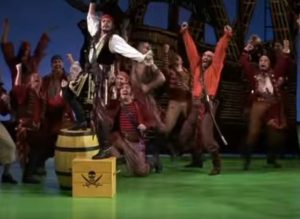
There’s more to this American opera, though, than “Summertime”, “I Got Plenty o’ Nuttin'”, and racial controversy. Here are 11 cool facts about Porgy and Bess to keep in mind the next time you see it or hear its amazing music (you can hear the Parker Symphony perform selections from Porgy and Bess on February 23).
“and Bess” was an afterthought: The opera was originally named “Porgy” throughout its creation. The “and Bess” portion was added to avoid confusion with the novel and play it was based on. The thought was also that the “and Bess” made it sound more operatic.
It was a box office flop: Porgy and Bess debuted on Broadway in 1935 (after its world premiere in Boston). Its original run included 125 performances which by opera standards is a huge success. However, for Broadway, that’s a theatrical failure.
Its performance resulted in an integrated audience: After the Broadway run, the opera went on tour to Philadelphia, Pittsburgh, Chicago, and, finally, Washington DC. In Washington, the cast, led by lead actor Todd Duncan, staged a protest of segregation at the National Theater. The theater intended to offer a special “blacks only” performance, but Duncan and the cast said they would never perform in a theater that prevented them from purchasing a ticket because of race. Management gave into their demands and the result was the first integrated audience for a performance of any show at that venue.
It has faced racial controversy over the years: Duke Ellington was said to have objected to its depiction of African Americans, although he later said the opposite. Harry Belafonte turned down the role of Porgy in the film version and the role when to Sidney Poitier. It is thought, however, that Gershwin never meant to insult African Americans. On the contrary, he insisted that it could only be sung by a black cast, a tradition upheld by Ira Gershwin that has launched the careers of several prominent black opera singers. George Gershwin sought to write a true jazz opera and he felt that the Met staff singers couldn’t master the genre.
Robert McFerrin sang the role of Porgy: Bobby McFerrin’s father, Robert, sang the role of Porgy in the 1959 film version. His voice was dubbed over Sidney Poitier’s.
The libretto was co-written by a former insurance agent: The libretto (the text used in the opera) was written by both Ira Gershwin and DuBose Heyward. Heyward was the co-author of the original “Porgy” novel which he wrote with his wife while he was working as an insurance agent.
The setting is fictional, but the inspiration is real: Porgy and Bess is set in the fictional neighborhood of Catfish Row, South Carolina. However, the setting and the story were inspired by the James Island Gullah community in South Carolina. In fact, most of the characters speak in the Gullah dialect. George Gershwin moved to Folly Beach, an island near Charleston, South Carolina, to draw inspiration from the Gullah community while composing the score.
It has been on Broadway seven times: Despite its initial failure, Porgy and Bess has been produced on Broadway seven times to date – 1935, 1942, 1943, 1944, 1953, 1976, 1983, and 2012. The 2012 production had the longest run at 321 performances.
It was a “first” for La Scala: Porgy and Bess was the first opera by an American-born composer to be performed at the famous opera house in Milan. The performance took place in 1955 and Maya Angelou was among the cast.
It was referenced in Sesame Street: The opera has undeniably made its mark in American music and culture, so much so that it was referenced in an episode of Sesame Street’s 36th season. Hoots the Owl sang a parody version of “A Women Is A Sometime Thing” to Cookie Monster called “A Cookie Is A Sometime Food”.
“Summertime” may be more popular than you know: Not only is it a memorable aria, but it has also been covered over 33,000 times by groups and solo performers.
Join the Parker Symphony Orchestra on February 23, 2018 to hear selections from Porgy and Bess and more. Tickets for Gone Too Soon are on sale now.




